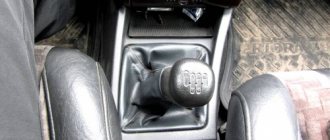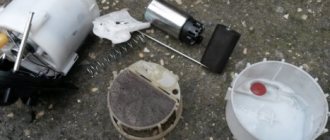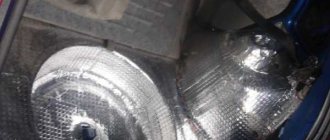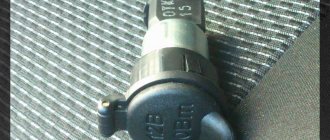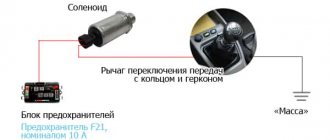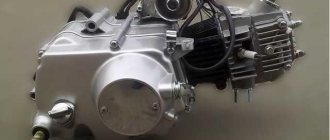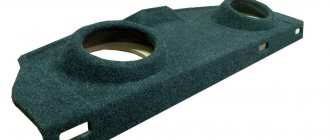Causes of gearbox failure
The complex mechanism constantly works under load and under extreme conditions. Constant vibration, rising temperatures, dust and dirt. If one or more speeds fail to turn on, you should check:
- cable tension and integrity;
- fastening the scenes;
- wear on the clutch disc;
- petals on a basket;
- bearing integrity;
- plug condition.
Clutch
When the clutch discs wear out, the pedal moves up and its position becomes higher than the others. In this case, when turned on, a crunching sound may be heard and the lever does not move, as if it is resting against an obstacle. You should not force the assembly, as this can lead to more serious damage - the gears will fly.
You can check by removing the rubber plug. The destroyed disc leaves fibers that look like tangled strands of hair. If such a phenomenon occurs, then a new clutch disc should be installed.
Cable
Due to constant loads, the cable stretches and must be periodically adjusted and tightened. In this case, the VAZ 21093 does not engage the first and second gears, and the rear may also fail. To fix the breakdown, you need to drive into the pit and tighten the cable. If it is worn out, replace it immediately. You can do this yourself.
A similar breakdown can also manifest itself in the failure of the gears to engage while the engine is running. Sliding along the splines is limited and fixation does not occur.
Basket
The reason for difficult shifting of individual gears, especially if there is a crackling sound that gradually fades during movement, may be the destruction of the spacer ring in the basket
Notice that there are drops of oil on the outside. Then remove the basket and check the O-ring and disc blades
Pay attention when purchasing new parts, because on some models the disk is missing and then you have to install pins and secure it yourself.
Backstage
A loose link must be tightened with an assistant. No special knowledge or skills are required, just the ability to hold the lever in the desired position while you crawl under the car and tighten the bolts. When the scenes on the VAZ 2109 are loosened, the speeds do not engage, and especially the rear ones.
Place the car on a hole or hill to have access to the bottom. Set the lever to neutral if several speeds do not engage. When only the reverse gear does not work, make adjustments using it. An assistant must hold the shift knob in the specified position without moving it anywhere.
It is necessary to loosen the bolt from below by 13, check the engagement of the gears, and having installed everything in place, tighten the bolt. If there is a problem with several gears, everything is done the same way, but it is set to neutral, or rather the shift knob is in the middle position. You can watch the video on how to do this.
Fork
Most often it fails on the road. If you slow down at a traffic light, the speed will not turn on to continue driving. A crack that forms on the fork body can lead to its destruction at any time, even under minor loads.
Principle of operation
The working diagram of the gearbox is as follows. The drive shaft receives rotation from the driven clutch disc and transmits it to the intermediate one. If the gearbox is set to neutral speed, there is no engagement of the intermediate shaft gears with the driven one, the car is immobilized, since rotation is not transmitted.
When a gear is engaged, the driver engages the driven element gear with a specific intermediate gear. And rotation begins to be transmitted from the driven shaft to the wheels. The car starts to move.
The necessary gears are engaged by a control unit consisting of three sliders and forks. Each of the forks is equipped with a special groove of the element. That is, the driver, using the gearshift lever and a special rocker, acts on a certain slider, moving it to one side. In this case, the fork on the slide pushes the gear, and it engages. The change in gear shift speed is influenced by engaging gears of different sizes and numbers of teeth.
To prevent the slider with the fork from returning to its original position, the box control unit is equipped with latches. The latter are spring-loaded balls that fit into grooves on the sliders. That is, the slide has grooves in certain places.
When moved to the desired position, the ball retainer jumps into the groove, eliminating the return of the slider. When changing speed, the driver must apply pressure on the slider that exceeds the force of the detent spring so that the ball pops out.
This is a simplified description of the design and operating principle of a manual transmission.
Typically, classic models work according to this scheme. On some cars the scheme may be slightly different, but the essence of the work is the same - the slider with the fork acts on the gear.
In some cars, the slider in the gearbox, which is responsible for engaging the first gear, also ensures that the reverse gear is engaged. It happens to them that first and reverse gears are difficult to engage
Of course, this breakdown cannot be ignored
On other gearboxes, first and reverse speeds are separated and different sliders are responsible for turning them on. In such cars, problems with engaging first gear may not be reflected in engaging reverse gear.
There are several options why first gear does not engage well. It also all depends on how the cause manifests itself - it is impossible to turn it on, and everything is accompanied by a metallic grinding sound from the side of the box, or the speed turns on, but immediately turns off on its own.
Reverse gear does not engage: common breakdowns
So, if engaging reverse gear is difficult or completely impossible, this breakdown is a common problem that can be encountered in different vehicles when changing gears.
Moreover, the rear does not engage both on manual and automatic transmissions (the reverse speed of the automatic transmission has disappeared)
Naturally, in such a situation, it is important to discover the cause of the malfunction and eliminate the breakdown, since it is simply impossible to operate the car normally without reverse gear (the vehicle is actually deprived of reverse gear). Let's figure it out
Let's start with a manual transmission and consider the question of why reverse gear does not engage in a manual transmission. First of all, with a manual transmission the reverse gear fails much more often than with an automatic transmission. As a rule, the first signs of problems are a grinding, crackling or crunching sound in the reverse gear when engaged, the reverse gear is difficult to engage, it is difficult to engage the speed after a while, etc.
As for the main malfunctions, we can highlight the following:
The clutch does not disengage completely. As you know, the clutch connects the engine and the gearbox, and at the moment of changing gears the driver must depress the clutch pedal and “disconnect” the internal combustion engine from the gearbox. After engaging the gear, the pedal is released, the clutch “closes” and the torque is again transmitted to the wheels.
So, if the clutch is not completely disengaged, the gearbox is not completely disconnected from the engine. This leads to the fact that all gears are difficult to engage. At the same time, on many cars, first speed and reverse do not have synchronizers. As a result, clutch problems are most noticeable when engaging reverse gear.
In such a situation, when trying to engage a gear, a crunching and grinding noise is heard in the box
To eliminate the breakdown, you need to pay special attention to the clutch (condition of the clutch disc, basket, release bearing, etc.). You also need to check the clutch adjustments, the quality of the pedal, etc.
The oil level in the gearbox is low or the gear oil has lost its properties. As practice shows, there is a common misconception among drivers that the manual transmission is filled with oil for the entire service life of the car. In fact, a maximum of 100 thousand km. Even the highest quality gear oil becomes unusable. And this is subject to fairly gentle operation.
If the car is used in difficult conditions (driving around the city, irregular pace, constantly switching speeds “up” and “down”, short trips, temperature changes, etc.), then the oil in the box requires replacement every 50-60 thousand. km. The fact is that the properties of the liquid change, additives are activated, dirt, products of mechanical wear of the box and various deposits accumulate in the oil.
The gearbox linkage needs to be adjusted; the rods or gearbox drive levers are deformed. Often, it is after diagnosing the condition of the rocker that it becomes clear why reverse gear on a Lada and various foreign-made cars (especially old ones or with high mileage) does not engage. Owners of front-wheel drive VAZ models are well aware that a poorly adjusted rocker is the reason why the reverse gear does not engage or is knocked out.
The solution in such a situation is to adjust the manual transmission gate, which can significantly improve the clarity of the inclusions and obtain the necessary softness. Also, in some cases, owners remove the standard mechanism and install a short-throw slide, but in this case you need to be prepared for the need for more careful adjustment. As for the gearbox rods and drives, these elements must be inspected for possible damage or breakage, after which they are replaced.
Design features of the gearbox. Often on budget cars, reverse and first gears do not have synchronizers. The absence of these elements, on the one hand, simplifies the design of the box, but on the other hand, difficulties arise when engaging reverse gear and first speed.
